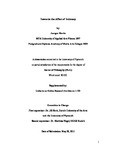Towards the Affect of Intimacy
| dc.contributor.supervisor | Ascott, Roy | |
| dc.contributor.author | Moritz , Juergen | |
| dc.contributor.other | Faculty of Arts, Humanities and Business | en_US |
| dc.date.accessioned | 2012-08-02T14:34:35Z | |
| dc.date.available | 2012-08-02T14:34:35Z | |
| dc.date.issued | 2012 | |
| dc.identifier | 374085 | en_US |
| dc.identifier.uri | http://hdl.handle.net/10026.1/1095 | |
| dc.description.abstract |
Abstract This thesis explores the trajectory that the developing technological fields of Ambient Intelligence and Persuasive Technologies introduce new intricate relationships beyond fundamental use and availability because they change our abilities to act. Since its classic articulation by Hegel (1927) philosophical explication of the relationship between people and technology states that technology is a mediating factor between people and the world. Associated with this view, which has characterized the resulting phenomenology and philosophy of technology for nearly two decades, is an understanding of technology as a form of alienation. In this dissertation the author shows how this old interpretation of the relationship between a person and their tool has emphasized how the person is active whilst the tool is passive. This traditional distinction fails to grasp the complex interaction between people and technology in the contemporary world. The nature of new technologies and novel theoretical work in this field suggests that this critical framework is now inadequate. Today, technology mediates the relationship between people and the world in increasingly complex and often collective ways. McLuhan (1967) stated: “Media evoke in us unique ratios of sense perceptions. The extension of any one of these senses alters the way we think and act”. As Greenfield (2006) and Fogg (2002) also posit, certain Ambient Intelligence and Persuasive Technologies are in-principle shaping everyday human behaviours in radically new ways. In particular, I explore how new technologies like those developed in the Artificial Companions Project can impact on our understanding of intimacy and identity. Indeed, Ambient Intelligence Technologies may play the role of reference groups (Shibutani 1987), groups who are real or imaginary and whose standpoints are being used as the frame of reference for the human actor. Given that these technologies have continuously reconfigured identification and profiling practices, this analysis rephrases insight of philosophers like Paul Ricoeur (1990), George Herbert Mead (1959) and Helmuth Plessner (1975) to trace how: The construction of our identity is mediated by how we profile others as profiling us. Thus, new technologies can become reference groups, encroaching on our everyday activities and even affecting our moral decision-making processes. As genuine upgrades of our practical space, they are destined to play a larger formative role in people’s lives in the future. Following Heidegger in Das Ding (Heidegger 1951), Latour once framed the wider social role of technologies as res publica or ‘public things’ (Latour 2005). He pointed out that the old German word ‘ding’ etymologically did not only infer ‘material object’ but also to assembly as gathering space - that thing that can bring together what it separates. Following Latour, Verbeek states that technological ‘things’ do not only mediate our existence, but are places where these mediations are made explicit – therefore, Verbeek argues, they are the places where people have to start to discuss and criticise the quality of the ways in which these ‘things’ help to shape our daily lives (Verbeek 2008). This thesis attempts to offer a new approach to this criticism through theoretical comparison and transdisciplinary analysis. | en_US |
| dc.language.iso | en | en_US |
| dc.publisher | University of Plymouth | en_US |
| dc.subject | Ambient Intelligence | en_US |
| dc.subject | Persuasion | en_US |
| dc.subject | Mediated Subjectivity | en_US |
| dc.title | Towards the Affect of Intimacy | en_US |
| dc.type | Thesis | |
| dc.identifier.doi | http://dx.doi.org/10.24382/3210 |
Files in this item
This item appears in the following Collection(s)
-
01 Research Theses Main Collection
Research Theses Main


